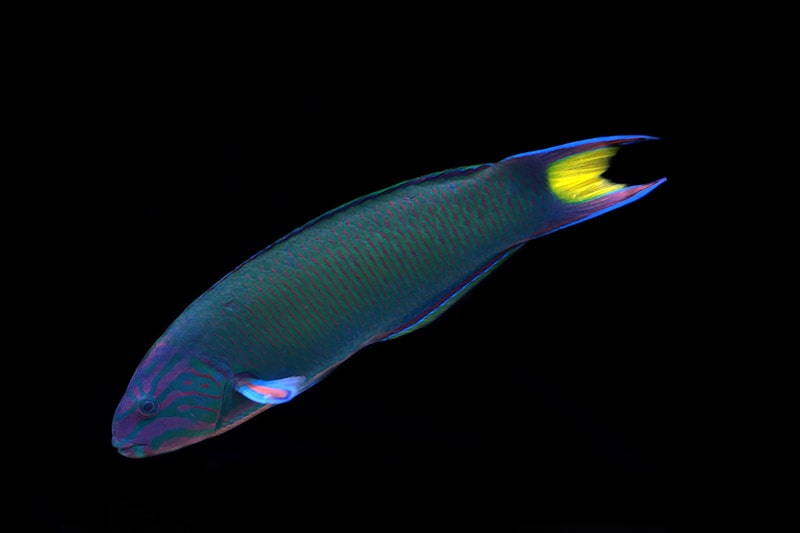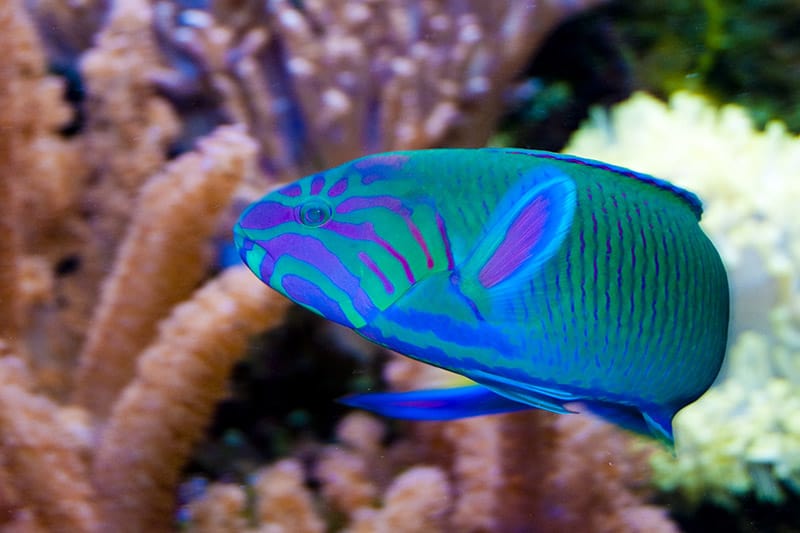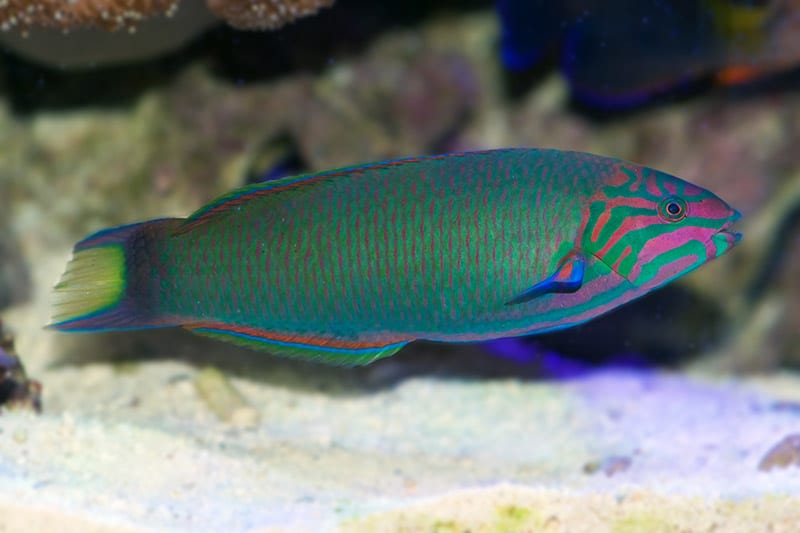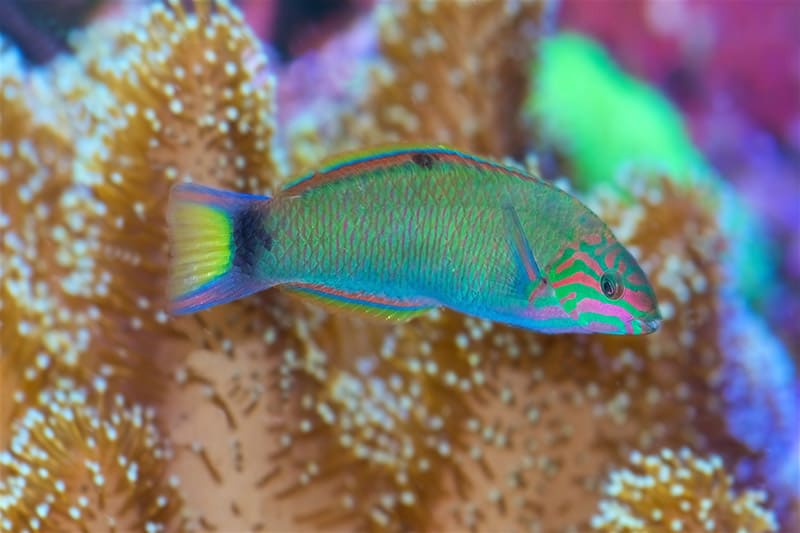The Moon Wrasse or Lunar Wrasse is the most popular, peaceful, and readily available wrasse in the Thalassoma genus,…and it is also very reasonably priced!
The Moon Wrasse or Lunar Wrasse is very popular and readily identified. All the common names of this wrasse are derived from a description it’s tail; Moon Wrasse, Lunar Wrasse, Lunare Wrasse, Crescent Wrasse, and Lyretail Wrasse. This is because as an adult, the yellow caudal fin becomes very ‘lunate’, which means shaped like a crescent moon with long upper and lower lobes. This fish is often confused with the Yellow Moon WrasseThalassoma lutescens, probably due to the cross-over in the common name, but they can quickly be differentiated when compared to each other.
This active wrasse is hardy, easy to maintain, and long-lived in the aquarium. Gaining length up to almost 10″, it is necessary for the Moon Wrasse or Lunar Wrasse to have plenty of swimming room. It is an excellent fish for the community aquarium as it is a peaceful fish, with only secondary males becoming aggressive. This wrasse doesn’t bother corals but it will eat crustaceans and invertebrates. When frightened this fish will hide in the rock work, or may bury itself in the sand.
- For more Information on keeping marine fish see: Guide to a Happy, Healthy Marine Aquarium
Scientific Classification
| Kingdom: | Animalia |
| Phylum: | Chordata |
| Class: | Actinopterygii |
| Order: | Perciformes |
| Family: | Labridae |
| Genus: | Thalassoma |
| Species: | lunare |
Habitat: Natural geographic location
The Moon Wrasse or Lunar Wrasse was described by Linnaeus in 1758. Found in the tropical Indo-Pacific oceans; from the Red Sea and East Africa eastward to the Line Islands, northward to southern Japan, and southward to Lord Howe Island and northern New Zealand. They prefer areas where there is clear moving oxygen rich waters in the shallow parts of lagoon and coastal reefs as well as protected outer reefs. They are found at depths down to about 65 feet (1 – 20 meters) swimming in small groups consisting of many initial phase fish (females and juveniles) with one dominant male.
This wrasse has reportedly formed a hybrid with the Klunzinger’s Wrasse Thalassoma rueppellii

Status
These fish are not listed on the IUCN Red List.
Description
The Moon Wrasse or Lunar Wrasse has a dark green to blue body with soft purple markings on each scale, the head is green to blue with irregular pink to violet stripes, and the pectoral fins have an elongated red spot. This wrasse basically retains the overall essence of its juvenile coloration, though juveniles have a dark spot on their caudal and mid-dorsal fins while adults can be recognized by the large yellow crescent on their caudal fin. Secondary males will have the most striking colors. The Thalassoma wrasses are known to be hardy and long lived in the aquarium.
Length/Diameter of fish
Adults can reach up to about 10 inches (25 cm), though in captivity most Thalassoma wrasses only grow to about 6 or 7 inches (15 – 18 cm).
Maintenance difficulty
These fish are very easy to keep and eat whatever food you may have for them. They adjust very quickly to aquarium life and prepared foods. Hardy beginner fish for a large aquarium. Generally not considered totally reef safe. Though they will not bother your corals they will eat your small crustaceans and invertebrates. Good for a community aquarium, usually peaceful though secondary males can become aggressive.
Foods
The Moon Wrasses or Lunar Wrasses are carnivorous, in the wild they eat benthic invertebrates, especially crustaceans such as crabs, shells, and shrimp. They also eat fish eggs and snail eggs. Having very hearty appetites, they are easily trained to eat prepared foods in the aquarium. Feed a varied protein diet strong in small crustacea, formulas and frozen foods such as mysis and brineshrimp, and thawed chopped raw fish, and even flake foods. They are heavy eaters that will eat anything and need to be fed 2 or 3 times a day.

Maintenance
Normal water changes at 10% biweekly or 20% monthly. For more information see, Marine Aquarium Basics: Maintenance
Aquarium Parameters
This fish needs to have a large aquarium with lots of space for swimming, a sandy substrate and, lots of rockwork for hiding and sleeping.
Minimum Tank Length/Size
A minimum 75 gallon (284 liters) or larger with a longer tank instead of a tall. A male and female may be housed together as long as the tank is 125 gallons or more.
Light: Recommended light levels
No special requirements but does enjoy patches of sunlight.
Temperature:
No special requirements. Normal temperatures for marine fish is between 74° and 79° F (23 – 26° C).
Water Movement: Weak, Moderate, Strong
Some strong currents and some normal areas, like the ocean provides.
Water Region: Top, Middle, Bottom
They will spend time in all parts of the aquarium.
Social Behaviors
They may be kept as a pair if the aquarium is 125 gallons or more. They are one of the more peaceful wrasses in the Thalassoma genus and can be kept with a variety of other fish without any problems. Secondary males (females that change into males), however can become aggressive and will need to be kept with aggressive similar sized or larger fish.

Sexual differences
Secondary or terminal males have the most intense coloring.
Breeding/Reproduction
Not yet bred in captivity. In their natural habitat they are known to do group type spawning.
Availability
The Moon Wrasse or Lunar Wrasse is readily available and inexpensive, ranging in price between about $20.00 to $30.00 USD.
Featured Image Credit: PAUL ATKINSON, Shutterstock
